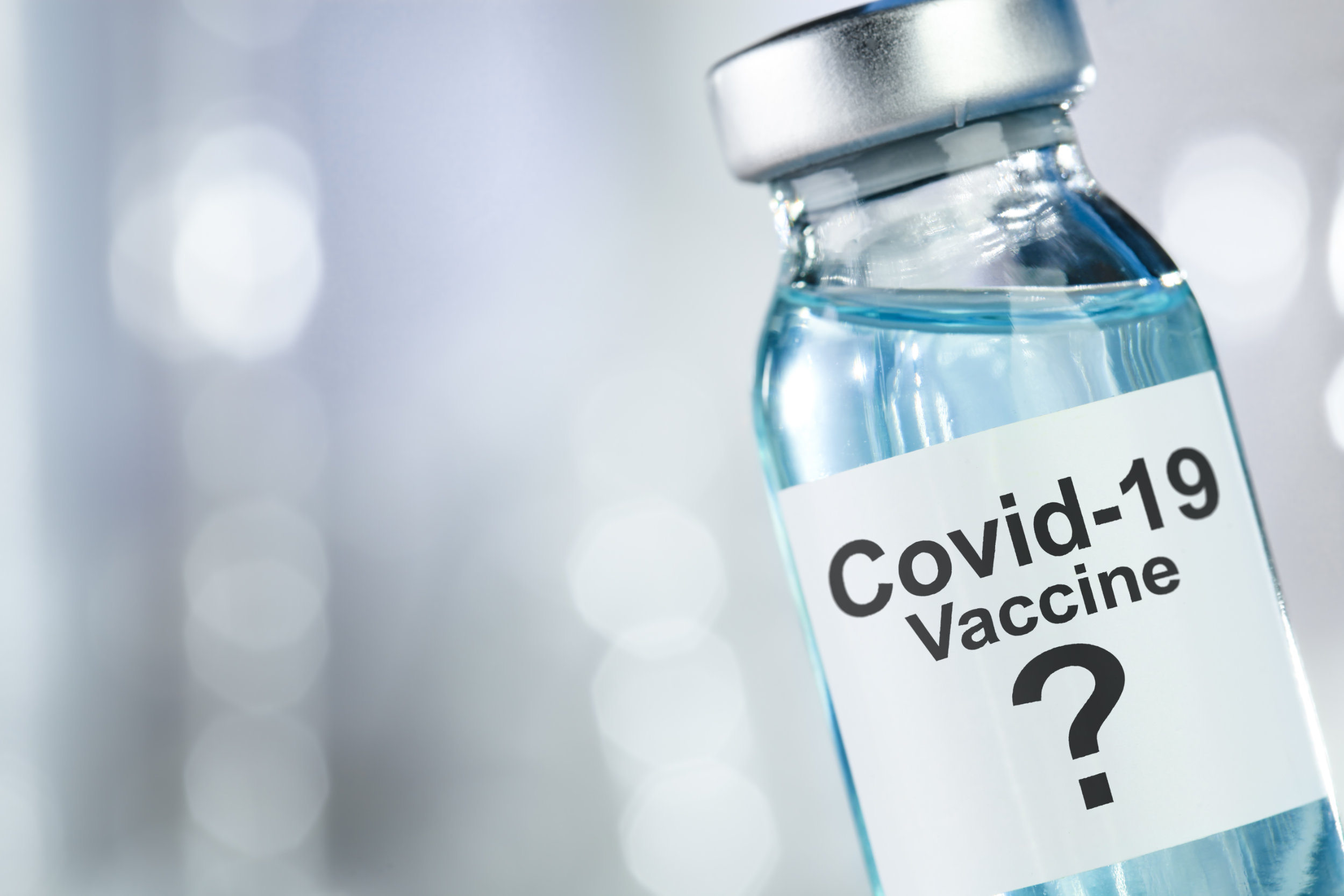
Vaccination against COVID-19: Need-to-know information to ensure informed consent
By Gary Sidley
In December 2020, accompanied by expressions of unbridled elation from politicians and the mainstream media, the UK began the roll out of a COVID-19 vaccine. This milestone closely followed the announcements of the initial results from three of the front-running drug companies in the vaccine race, Pfizer-BioNTech, Moderna and Oxford-AstraZeneca, all reporting high levels of efficacy for their new vaccine. The Government’s intention is to offer the jab to the large majority of the UK population, starting with the most vulnerable groups – the elderly and those with underlying health problems.
But is it in everyone’s interest to take the vaccine when the opportunity arises?
Within a civilised society each of us retains the fundamental right to decide whether or not to accept a medical intervention, including the offer of a drug or vaccine. In order for an individual to make an educated and rational judgement, all relevant information – about both the likely benefits and disadvantages of the medicinal chemical – should be made available to the potential recipient. It is only by careful consideration of this range of information can a person give ‘informed consent’ to accept the treatment. So with regards to the COVID-19 vaccines, what are the need-to-know facts?
It makes sense for each of us to assess the risks and benefits of accepting the vaccine, taking into account age and current health status. To aid this process, here are five questions to ask when deciding whether to say yay or nay, followed by my attempt to offer the relevant information.
1. If I become infected with SARS-COV-2 virus, what is the actual risk of becoming ill, or dying?
If you contract the SARS-COV-2 virus, there is about a 1-in-5 chance that you will suffer significant COVID-19 symptoms, the large majority of those testing positive showing either no or very mild signs of illness. Considering all age groups together, around 1-in-100 infected people will require hospital treatment and 1-in-750 will require intensive care. For older people (>70 years), the average risk of hospitalisation may be as high as 1-in-20.
Overall, the Infection Fatality Rate (IFR) of SARS-COV-2 is in the range 0.15 to 0.2%; in other words, for every 1,000 people who contract this virus no more than two people will die. The mortality risk is largely determined by age, the threat growing steadily with advancing years. The average age of those dying is 82 (slightly above normal life expectancy). The IFR for people below the age of 70 is between 0.03 and 0.04%; for every 10,000 people infected, 3 to 4 will die. About 95% of fatalities will have had serious underlying conditions.
For healthy people under the age of 35 the additional fatality risk of contracting SARS-COV-2 is almost zero. Meanwhile, children are as good as bullet proof, with seasonal influenza presenting a much greater risk of mortality to under-15-year-olds.
A useful rule of thumb for understanding age-related risk levels is to remember that contracting SARS-COV-2 virus is like packing a full year’s worth of death risk into a four-week period. Thus, on a child’s 10th birthday the chances of that child not reaching their 11th birthday is vanishingly small; this tiny probability is roughly equivalent to the risk of this 10-year-old dying from a SARS-COV-2 infection. In contrast, an 85-year-old person will typically have a 10% chance of not surviving until their next birthday, and around a 10% risk of dying within four weeks should they contract the virus.
In summary: For healthy people under 50, the risk of serious harm from SARS-COV-2 is vanishingly small, with other threats (for example, cancer and accidents) presenting a greater risk. The risk of the virus for old people is many-fold greater, but even a reasonably-healthy-90-year-old will have over 90% chance of survival.
2. To what extent will the vaccine reduce my risk of being hospitalised or dying from COVID-19?
The brief response to this question is that the experts do not yet know. All the research trials (including those undertaken by Pfizer-BioNTech, Moderna and Oxford-AstraZeneca) are primarily configured to test whether the vaccine can significantly reduce the severity of symptoms. To quote a recent editorial from the British Medical Journal]: ‘None of the trials currently under way are designed to detect a reduction in any serious outcome such as hospital admissions, use of intensive care, or deaths.’
It is, however, clear that the vaccines will achieve a positive impact upon the severity of subsequent COVID-19 symptoms suffered in the aftermath of infection. Both the Pfizer-BioNTech and the Moderna trials reported that their respective vaccines were around 95% effective in preventing COVID-19. This positive conclusion derives from the finding that only about 5% of the participants who subsequently displayed symptoms were in the vaccine group – 8 out of 170 (Pfizer-BioNTech) and 11 out of 196 (Moderna). Furthermore, in the latter trial, the 30 ‘severe’ cases were all in the placebo group. Clearly, these vaccines offer some meaningful protection against COVID-19.
To aid informed consent, however, it is appropriate to contextualise these initial, impressive-sounding claims of the vaccines’ therapeutic benefits and consider the actual (‘absolute’) risk of COVID-19 for each participant in the trials. For each of the 44,000 volunteers in the Pfizer-BioNTech study, the average risk of developing COVID-19 symptoms was 0.74% in the placebo group and 0.04% in the vaccine group, an absolute risk reduction of 0.7%. Similarly, the corresponding risk benefit of the vaccine for the participants in the Moderna trial was 0.6%. If we restrict the calculation to severe COVID-19 symptoms, the absolute risk reduction falls to 0.05%. Such levels of risk reduction from vaccination, although potentially important for some highly vulnerable people, might for most of us be synonymous with taking a prophylactic Lemsip for a bad cold that you will probably never catch.
Although it is plausible that a vaccine-induced symptom reduction may reduce hospitalisations and deaths, any claims of this sort will be based on less robust data emerging from the rollout of the vaccine rather than from the controlled trial (the latter having insufficient statistical power to assess these relatively rare outcomes). To say anything meaningful about hospitalisations and deaths, the vaccine trials would need to include far more participants and last much longer. In the words of Tal Sacs (Chief Medical Officer at Moderna), ‘The trial is precluded from judging hospital admissions, based on what is a reasonable size and duration to serve the public good here’.
Importantly, although the trials include some elderly people – the population most at risk of life-threatening illness – they represented only a small fraction of the participants. Those 75 years or over constituted no more than 5% of the total in any of the three trials, insufficient to draw firm conclusions about the protective value of vaccines against life-threatening illness for this vulnerable group.
Finally, it is also worth noting that the dramatic increase in the use of influenza vaccines may not have led to a decline in mortality.
In summary: Although it is possible that the symptom reduction from vaccination might reduce hospitalisation and save lives, there is as yet no robust evidence to support such claims.
3. Will vaccination lead to immunity and make me less likely to transmit COVID-19?
At first glance, this sounds like a silly question. When we hear the word ‘vaccination’ we automatically assume that it refers to a process that will render us less likely to contract or transmit a virus or bacterium; indeed, a typical dictionary definition for the word ‘vaccinate’ is: to inoculate (a person) with a vaccine so as to produce immunity against a specific disease (Collins English Dictionary). Yet, surprisingly, the vaccine trials are not designed to show that vaccination provides protection against infection with the SARS-COV-2 virus. In the words of one academic reviewer, ‘This could lead to vaccines that, although protecting from symptomatic disease, might still enable transmission of the virus’.
As often is the case, it is the cost and practicalities that it is claimed preclude the trials from showing if vaccines confer immunity. With regards to the Moderna vaccine, Tal Zaks said, ‘Our trial will not demonstrate prevention of transmission, because in order to do that you have to swab people twice a week for very long periods, and that becomes operationally untenable.’ The other vaccine trials display the same limitations.
While there is as yet no evidence that the vaccines will protect the recipient, one could speculate that a small proportion of vaccinated people (those that realise a reduction in severity of subsequent COVID-19 symptoms) might be less infectious to others. In the same way that people without symptoms while testing positive for SARS-COV-2 do not significantly contribute to viral spread, it is plausible that a vaccine-induced reduction in symptoms may be associated with less infectivity. However the degree and real-world significance of any such effect following vaccination cannot be gleaned from the trials.
Curiously, the Government’s expressed aspiration to vaccinate virtually all of the UK’s adult population seems to ignore the likelihood that at least 30-to-50% of us will have pre-existing immunity due to the existence of T-cells and previous exposure to coronaviruses (including SARS-COV-2 and those responsible for the common cold).
In summary: Contrary to what many assume, there is as yet no evidence that the vaccines will reduce the likelihood of contracting COVID-19.
4. What sort of side effects might I experience after vaccination?
Short-term side effects
The degree of discomfort associated with side effects is typically described as either ‘severe’ or ‘mild to moderate’. With regards to short-term ‘severe’ negative consequences, the COVID-19 vaccines appear to evoke a higher frequency of strong adverse reactions than most flu vaccines. Thus, soon after the jab, those in the Moderna trial suffered severe fatigue (10% of participants), severe muscle pain (9%), severe headache (5%) and severe joint pain (5%). Severe short-term side effects for the Pfizer-BioNTech trial are reported to be less frequent; for example, severe fatigue (4%) and severe headache (2%) – although this reduction might result from the fact that participants in the vaccine arm used far more pain and fever medications immediately following vaccination than those in the control group.
As for ‘mild to moderate’ short-term side effects, the rate is – of course – much higher with vaccine recipients reporting pain at the injection site (80%), fatigue (60%), headache (50%), muscle aches (30%), chills (30%) and fever (10%). It is important to note that these less intense symptoms may often represent more than a mild inconvenience; in the vaccine world, ‘moderate’ intensity can be defined as sufficient to render a person unfit to work for several days.
The short-term side effects in the Oxford-AstraZeneca study appear less common than those in the Pfizer-BioNTech and Moderna trials. This difference might be a product of the latter two investigations using a never-before-used technology which involves the injection of genetic material (modified mRNA) rather than the more traditional process (adopted by Oxford-AstraZeneca) of vaccinating with inactivated or weakened forms of the virus itself. Alternatively, the apparently less-frequent side effects in the Oxford-AstraZeneca trial might simply be an artefact of using a meningitis vaccine as the placebo comparison (which itself would produce significant side effects) rather than inert saline solution.
Novel technology
Some of the vaccine development projects, including the Pfizer-BioNTech and Moderna trials, deployed a never-before-used technology which involves the injection of genetic material (modified mRNA). This new scientific method – which represents a step into the unknown – raises additional safety concerns.
One specific issue is with regards the risk of the mRNA vaccines impacting on female fertility. The SARS-COV-2 spike protein (the thing that vaccines aim to destroy) is of the same protein family as proteins (syncytins). Though there is no laboratory evidence for this concern, there is a potential risk that vaccination might reduce the chances of sustaining a pregnancy. In recognition of this concern, the Government experts initially recommended that the vaccine is not given to pregnant women (although recently this guidance has been softened to encouraging pregnant women to ‘discuss the risks & benefits of vaccination’.
Another concern with the mRNA vaccines is that their main ingredient used for packaging purposes, polyethylene glycol, may evoke severe allergic reactions in some people. Such reactions are characterised by rashes, a plummeting blood pressure, shortness of breath, and a fast heartbeat; on rare occasions they can be fatal.
Long-term, potentially life-changing, side effects
Prior to 2020, the process to create a new vaccine typically lasted 10 to 15 years, involving planning, development, testing and manufacture. In stark contrast, the front-running COVID-19 vaccines have been produced in 10 months. There are understandable reasons for this remarkable achievement (prior knowledge regarding the target spike protein, reliance on data from similar vaccine studies, no financial risk for the drug companies, ‘emergency authorisation’ granted by the regulators) but an important consequence of this haste is the absence of any data about the risk of serious late-emerging side effects. Furthermore, the long-term safety data may never be available due to the likelihood that participants in the placebo arm of the trials will be offered the vaccine shortly after it is approved by the regulator, thereby preventing any robust comparison between the vaccinated and the non-vaccinated. The monitoring of any emerging adverse reactions during the mass roll out of the vaccine to the general population will, in effect, act as the surveillance process for any delayed negative consequences.
And there have been occasions where previous vaccines have been linked with serious harms to the recipients. For example, a vaccine called Pandemrix – widely administered during the ‘swine flu’ pandemic of 2009 – was later found to be associated with narcolepsy (a long-term neurological disorder characterised by uncontrollable sleep attacks, excessive drowsiness and sudden loss of muscle control). The victims subsequently received multi-million pounds in compensation.
As for the COVID-19 vaccines, two further concerns have been raised about the potential for late onset, serious side effects. Firstly, previous attempts to develop vaccines for other coronaviruses have been hampered by the discovery that, in the aftermath of vaccination, some recipients become markedly more susceptible to developing severe illness when they come into contact with the natural virus. This phenomenon, referred to as ‘antibody dependent enhanced immunity’, can occur months or years after vaccination and has, on occasions, led to the deaths of humans and animals involved in the trials.
Secondly, two vaccine recipients in the Oxford-AstraZeneca trial developed an extremely dangerous neurological condition known as ‘transverse myelitis’. Characterised by inflammation of the spinal cord, this serious affliction can cause weakness of the limbs, pain in the lower back, abnormal bodily sensations and bowel and bladder dysfunction. Reassuringly, the risk of the vaccine evoking transverse myelitis is very small, perhaps as low as 1 in 3000. (It is, however, worth bearing in mind that if 30 million UK citizens receive this vaccine we would expect about 10,000 cases).
In summary: Most vaccine recipients can expect to experience some short-term discomfort, with a significant minority suffering symptoms of sufficient intensity to interfere with day-to-day functioning. The novel mRNA technology, together with the absence of long-term safety data, prevents any reliable estimate of the risk of late-emerging serious conditions.
5. Should I have total confidence in what I’m being told by the drug companies, scientists and World Health Organization?
No one is devoid of self-serving biases, and the risk of distortion in the reporting of data and subsequent decision making will be ever present. Although, without doubt, the vast majority of professionals and administrators involved in the response to a pandemic strive to display integrity, when there are conflicts of interest around funding and career progression partiality is inevitable. So what does history tell us about the major stakeholders involved in the SARS-COV-2 pandemic?
Pharmaceutical industry
A strong case can be made to support the assertion that ‘Big Pharma’ is the most corrupt industry in the world. In the last 20 years, the pharmaceutical industry has – in total – been fined over $14 billion for a variety of malpractices. For example, Pfizer (a front runners in the COVID-19 vaccine race) has been compelled to pay out a total of $4.7 billion, including $3.3 billion for 10 offences relating to ‘unapproved promotion of medical products’ and $104 million for five offences of ‘drug/medical equipment safety violation’. AstraZeneca (another pioneer in the vaccine race) has been fined over $1.1 billion by the regulatory authorities, incorporating $543 million for 12 instances of ‘false claims’ and a $5.5 million penalty for ‘kickbacks and bribery’. Given this murky history, it is wise to display a degree of scepticism about the validity of the initial proclamations about the success of their vaccine trials, particularly in light of their current indemnity from liability
Research studies sponsored by the pharmaceutical industry – like the COVID-19 vaccine trials – are notorious for their self-serving distortions (Goldacre, 2012). Common slights of hand include the use of trivial outcome measures that are of little consequence to the patient and failing to report the intended outcomes because they show the new drug in a poor light. There is more than a whiff of these manoeuvres in the preliminary reports of the vaccine trials. As previously discussed, claims of ‘90% effectiveness’ in the PfizerBioNTech and Moderna trials can be misleading. Furthermore, the preliminary report of the results of the Oxford-AstraZeneca trial – with its reference to efficacy ranging from 62% to 90% ‘depending on dosage’ – smacks of bad science, where the planned outcome measure was disappointing so they’ve trawled the statistical permutations to find something better. Another flaw in the same trial derives from the fact that two of the three research arms were only single blinded (in other words, the investigators were aware of who had received the vaccine and who the placebo) thereby raising the likelihood of bias in the subsequent reporting of COVID-19 symptoms.
SAGE scientists
SAGE is the name given to the influential group of scientists who have been advising the Government throughout the SARS-COV-2 crisis. A prominent member of SAGE (until he resigned in May 2020 after breaking the lockdown restrictions) was Professor Neil Ferguson, the man leading the Imperial College London team of modellers responsible for the prediction that the first wave of the virus could kill in excess of 500,000 people in the UK; this hugely pessimistic forecast was the major driver of the national lockdowns. Other key members of SAGE include Professor Chris Whitty (England’s Chief Medical Officer), Sir Patrick Vallance (Chief Scientific Officer) and Professor Stephen Powis (Medical Director of NHS England). Given the pivotal role of SAGE in shaping Government policy, including in regards to the vaccination programme, it’s important that we can have total confidence in the impartiality of their advice.
An investigation of the backgrounds of the 20 most frequent attenders at SAGE meetings (January to April, 2020) revealed that 12 of them had potential conflicts of interest that might have influenced their judgements about the pros and cons of vaccines. These conflicts included: shareholdings in drug companies that manufacture vaccines; employment in university departments receiving millions of pounds of Government money to develop vaccines; and the receipt of funding from pro-vaccine organisations such as the Gates Foundation and the Wellcome Sanger Institute. Given these parallel incentives, it would be reasonable to suggest that the objectivity of their advice could be compromised.
World Health Organization (WHO)
The WHO – the specialised agency of the United Nations responsible for public health – has often come under scrutiny about its relationship with industry, and how external agencies (particularly those funding the WHO) might disproportionately impact on the organisation’s decision making and recommendations. For example, a joint investigation by the British Medical Journal and the British Bureau of Investigative Journalism around the time of the 2009 ‘swine flu’ pandemic uncovered some disturbing conflicts of interest. In particular, they found that WHO, in the process of developing their guidance, routinely took advice from scientists with declarable financial ties with drug companies producing ant-viral drugs and vaccines. Furthermore, the WHO, the public health system and the pharmaceutical industry all drew on the same pool of scientific ‘experts’. Worryingly, there is no reason to expect that anything has changed during the 2020 pandemic.
In summary: Although we would expect that the individuals involved in decisions around vaccines would display integrity and be guided by the common good, the manifest conflicts of interest embedded in the public health system raises concerns about the impartiality of the information presented to the public.
Concluding comments
I hope the above information will contribute to readers’ knowledge so that each person can make an informed decision about whether to accept the COVID-19 vaccines. Taking everything into account, as an active 62-year-old, I will be saying no on this occasion and await further evidence from the vaccine rollout about the levels of effectiveness and potential side-effects. And fingers crossed we can repel the imposition of ‘vaccine passports’.
Reference:
Goldacre, B. (2012). Bad Pharma: How drug companies mislead doctors and harm patients. London: HarperCollins.
Disclaimer: We at Prepare for Change (PFC) bring you information that is not offered by the mainstream news, and therefore may seem controversial. The opinions, views, statements, and/or information we present are not necessarily promoted, endorsed, espoused, or agreed to by Prepare for Change, its leadership Council, members, those who work with PFC, or those who read its content. However, they are hopefully provocative. Please use discernment! Use logical thinking, your own intuition and your own connection with Source, Spirit and Natural Laws to help you determine what is true and what is not. By sharing information and seeding dialogue, it is our goal to raise consciousness and awareness of higher truths to free us from enslavement of the matrix in this material realm.
 EN
EN FR
FR



























There is enough evidence that this virus is not natural but has been produced in a laboratory and patented. How come we are Not giving punitive measures To the producers alongside the preventive measures. What is the guarantee that by the time we finish taking the preventive measures the producers won’t come out with another strain since this whole is driven by the profit motif and the reduction of human population. It has been going on for centuries and they are left untouched. For once let them be dealt with to deter other future producers